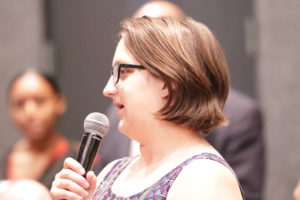Oct. 5 Summit Spotlight: Ohio community builders visit Westside, find “Promise”
For Westside Future Fund, our commitment to community, collaboration and partnership extends beyond the six neighborhoods in our footprint and Atlanta’s city limits.
We believe that the #PowerofWe is inclusive of all who are working to bring equity and opportunity to communities, and we welcome the opportunity to share what we’ve learned as others have shared with us. At our Oct. 5 Transform Westside Summit, we were granted the chance.
We were hosts to Dr. Bob Welker and Kali Lawrence, representatives from the Springfield Promise Neighborhood (SPN), a place-based and asset-based poverty alleviation project. It centers its work with residents in a 110-block area in Springfield, Ohio, which is the attendance zone of local school Lincoln Elementary.
Dr. Welker and Lawrence traveled to Atlanta specifically for an on-the-ground view of Atlanta’s Westside revitalization efforts that share many of their own project’s opportunities and challenges.
Read our Q&A below with Lawrence about why they felt it important to visit Atlanta’s Westside, what they learned during their visit and their hope for communities like Atlanta’s Westside and their very own Springfield.
What brought you to Westside Future Fund’s October 5 Transform Westside Summit?
We are undertaking a series of case studies to investigate successful Choice Neighborhood grantees and their strategies for community and economic development. Atlanta also happens to be the place where Bob’s son, John, has started his own ballet company, Terminus Modern Ballet Theatre. That provided an introduction to learning about the Summit and the work of the Westside Future Fund.
What was your biggest takeaway from the meeting?
The revitalization of an entire community requires the persistence of effort as well as a blend of sustained fiscal and human resources. It was exciting to see how WFF had built upon multiple historic plans and programs to extend them strategically as well as to help leverage the additional funds required for structural change. This is not work for the faint-hearted. When I tell people about WFF, I will tell them about the absolute requirement to create purpose and talent behind a vision that was aptly called the “Beloved Community.” This inclusive ideal requires resident involvement and a commitment to avoiding the traps of gentrification and keeping residents in their homes.


Lawrence and Welker during the Summit’s self-introductions.
Was there anything surprising or unexpected?
We were delighted to see the efforts in housing, particularly with the goal of providing an avenue for police and teachers to locate in the Westside. Springfield Promise Neighborhood is founded on providing for the success of children by a place-based approach working with a target school and a target neighborhood. We love the phrase “It takes a village to raise a child.” But we don’t have villages in our urban communities in any way that provides that phrase its power. Teachers, individual business owners, community youth workers and many of the faithful church members have departed. Reversing that intentionally is profound work.
You both traveled to Atlanta from Springfield, Ohio where you’re working in a similar fashion to alleviate poverty and support the creation of healthy, thriving communities. What about the Westside revitalization and Westside Future Fund piqued your interest?
We are interested in learning about the opportunities for cross-sector investment, particularly from corporations, as well as strategies for housing development and investment. We were excited about the interest and engagement from the grassroots level up to CEOs of multimillion-dollar companies. We were especially interested in the concept of a youth center as a response to safety, with the support of the Atlanta Police Foundation, in addition to education and career-readiness opportunities. Encouraging and creating space for police officers to become neighborhood residents that have a personal stake in the success of their community is inspiring.
Was there anything you felt you might be able to take back to your work in Springfield?
The Summit we attended focused on the benefit to be held in Mercedes Benz Stadium. It’s possible because of the difference in scale to think that we could never hold anything like this in a community of 60,000 people. But the importance of the event was the collective effort involved, the design of the program and seating that would accommodate a range of people and contributors and the specific naming of multiple non-profits that might receive funding. Many of the problems and issues we heard about in our visit are mirrored in Springfield and include the difficulties of fully-invested community engagement. Scarcity in funding streams is one hurdle to collective partnerships, so we were impressed by this larger community effort.
Is there anything you’ve learned from your work in Springfield that you’d like to pass along to those on the ground in Atlanta?
Youth As Resources (YAR) is a youth-led grantmaking and service learning organization that allows young adults to develop service projects, create a grant request to YAR, and then enact those projects in their neighborhoods. It is facilitated by a board with heavy engagement, oversight and advice from youth to their peers. It allows young adults to tackle the issues immediately around them. Many youth groups in Springfield have designed and implemented service projects within their schools and neighborhoods. Of course, the challenge is sustainable fundraising.
What is your hope for communities like the Historic Westside and Springfield?
Since we work with the success of youth so firmly in mind, we are constantly challenged with issues around the achievement gap that includes everything from test scores, to attendance, to behavior, to issues of equity and access to educational, health and human services. We wish for a community of inclusion where it is a good place to settle and raise a family. Pretty simple and pretty basic. This has to do not simply with a focus on gaps, but also in incorporating and providing the multiple developmental community assets required for a child to thrive.
To learn more about the Springfield Promise Neighborhood, visit www.springfieldpromise.com.
